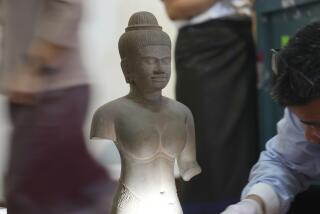War turns heads toward Middle East
- Share via
This was a year when war heightened awareness of the art of the Middle East. For all the wrong reasons, the cultural heritage of Iraq and surrounding regions grabbed attention and made long-planned exhibitions at American museums seem extraordinarily timely.
The consciousness-raising began in 2001, when Taliban officials ordered the destruction of all pre-Islamic art and artifacts in Afghanistan. Two giant statues of Buddha, carved into stone cliffs near Bamian in the 3rd and 5th centuries, and some 2,750 artworks at Kabul’s National Museum were obliterated.
This year, the horrifying spectacle of a nation’s cultural heritage under siege shifted to Iraq.
Soon after U.S. forces took control of Baghdad, there were reports of wholesale looting at the Iraq Museum, the world’s foremost collection of Mesopotamian antiquities. Early estimates put the loss at about 170,000 objects and galvanized an international contingent of museum directors, art historians and conservators.
“The burden to provide remedies belongs to all of us,” Philippe de Montebello, director of the Metropolitan Museum of Art in New York, said in a public statement. “For just as the storied collections of the Baghdad Museum reflected the roots of so much of global civilization, the obligation to save what might yet be saved, and return what must quickly be returned, must be shared by citizens throughout the globe.”
Estimates of the loss soon plummeted. Many missing pieces had been put into storage for safekeeping; others were returned by the thieves. Investigators now say that about 3,000 objects -- including a few major pieces -- have yet to be found. But the ongoing story has sparked intense interest in exhibitions that focus on Middle Eastern art or include it in broadly conceived Asian surveys.
De Montebello made his statement at the mid-April opening of “Art of the First Cities: The Third Millennium B.C. From the Mediterranean to the Indus,” a landmark show at the Met that packed in crowds through the summer. Three other New York shows of Middle Eastern material continue into the new year: “Hunt for Paradise: Court Arts of Safavid Iran 1501-1576,” at the Asia Society (to Jan. 18); “Persian Silks of the Safavid Period,” at the Met (to Feb. 29); and “Petra: Lost City of Stone,” an exploration of an ancient city in Jordan, at the American Museum of Natural History (to July 6).
In Los Angeles, the County Museum of Art opened “The Legacy of Genghis Khan: Courtly Art and Culture in Western Asia, 1256-1353” -- including material from the region of modern Iraq and Iran -- soon after the war in Iraq began. The timing was coincidental, but Linda Komaroff, the museum’s curator of Islamic art, thought it propitious.
“If any other exhibition were opening at LACMA, it probably would not be a good time because it would be hard to compete,” she said. “This happens to be a subject matter that -- unfortunately, because we don’t want there to be a war -- ties in with the news.”
More than 70,000 people attended the show during its 10-week run.
Such exhibitions take many years to develop, but the museum responds to heightened interest in Middle Eastern art on a regular basis by building its collections and rotating exhibits in its Islamic art galleries, press officer Bo Smith said.
Meanwhile, a group of Los Angeles-based Middle Eastern artists has launched Articultural Gallery, at 10469 Santa Monica Blvd., to present contemporary works by artists from Asian countries. A recent show featured the work of 13 Iranians. Next year’s lineup offers artworks by Arabs, Armenians and perhaps three Iranian women who have been political prisoners.
“We do our best to close certain cultural and political gaps through art,” said gallery director Farzad Karimi. “We chose the name Articultural because it sounds like ‘agricultural.’ We want to provide new ground for artists.”
More to Read
The biggest entertainment stories
Get our big stories about Hollywood, film, television, music, arts, culture and more right in your inbox as soon as they publish.
You may occasionally receive promotional content from the Los Angeles Times.










